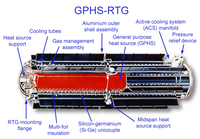
Photo from wikipedia
Mountain glaciers are highly sensitive to climate change. In this paper, we systematically analyzed and discussed the responses of glaciers to climate change during 1960–2017 in western China by the… Click to show full abstract
Mountain glaciers are highly sensitive to climate change. In this paper, we systematically analyzed and discussed the responses of glaciers to climate change during 1960–2017 in western China by the methods of least squares and correlation analysis. Results show that the maximum temperature, minimum temperature, average temperature, and precipitation significantly increased in western China at the rates of 0.32°C/10a, 0.48°C/10a, 0.39°C/10a, and 11.20 mm/10a, respectively. However, the wind speed, hours of sunshine, snowfall, and snowy days displayed decreasing trends at the rates of −0.53 m/(s·10a), 3.72 h/10a, −2.90 mm/10a, and −0.10 d/10a, respectively. The annual percentage of glacier area decreased by approximately 0.42%, and the average glacier area decreased by 2.76 km2/a. Meanwhile, glacial shrinkages were greater in the Altay Mountains, Tanggula Mountains, and Qilian Mountains than in the other mountainous regions. Glacier accumulation decreased while melt volume increased at a rate of 2.7×104 m3/a. The area of melt volume was 1.3 times that of the glacier accumulation area. The glacier mass balance (GMB) decreased substantially at a rate of −14.0 mm/a, whereas the equilibrium line altitude (ELA) showed an increasing trend at a rate of 0.5 mm/a. After 1997, the mass was smaller than −500.0 mm, indicating a huge loss in glaciers. Furthermore, relationships between ELA and GMB and various climatic factors were established. Temperature and precipitation demonstrated a significantly negative correlation, whereas wind speed and snowy days had significantly positive correlations with GMB. Snowy days also exhibited a remarkably negative correlation with ELA. The strong warming trend and less snowy days were thought to be the main factors leading to glacial melting, whereas the increase in precipitation, and reductions of sunshine hours and wind speed might slow glacial melting.
Journal Title: Journal of Arid Land
Year Published: 2019
Link to full text (if available)
Share on Social Media: Sign Up to like & get
recommendations!